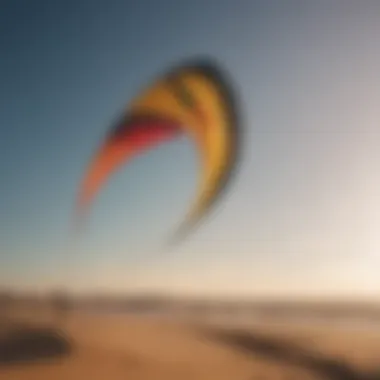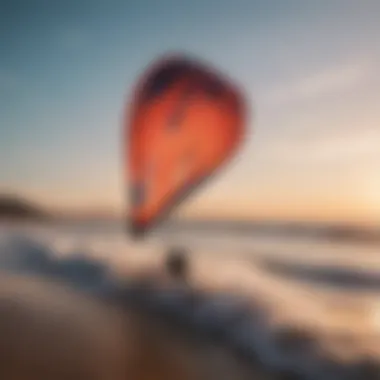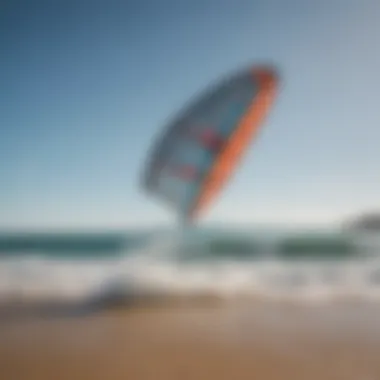Mastering the Art of Kite Line Selection: A Definitive Guide for Kitesurfers


Equipment Reviews
Kitesurfing and kiteboarding enthusiasts always strive to stay at the forefront of innovations in equipment to enhance their performance on the water. Whether you are a seasoned rider looking to upgrade your gear or a novice seeking guidance on the best equipment to start with, understanding the key components of kitesurfing gear is paramount.
Kites: The Heart of the Experience
Kites are the cornerstone of kitesurfing, dictating the rider's experience on the waves. Understanding the nuances of kite shapes, sizes, and materials can significantly impact your performance. From delta shapes to bow kites, the variety of kite types available caters to different riding styles and conditions. Cutting-edge features like bridles, pulleys, and inflation systems further differentiate modern kite models, optimizing control and efficiency during maneuvers.
When examining kite options, leading brands in the kitesurfing industry like North Kiteboarding, Cabrinha, and Ozone boast a wide array of offerings designed to meet the diverse needs of riders worldwide. Considerations such as wind range, depower capabilities, and relaunch characteristics play a pivotal role in selecting the ideal kite for your kitesurfing adventures.
Boards: Crafting the Perfect Ride
A crucial component of kitesurfing gear, kiteboards come in various shapes and sizes to suit different riding preferences. Whether you prefer the agility of a twintip board or the directional control of a surfboard-style design, the choice of board significantly influences your riding style and experience on the water.
Each board's construction materials, such as wood, carbon fiber, or foam core, contribute to its flex, weight, and durability. Manufacturers like Slingshot, Naish, and Duotone excel in producing high-performance boards tailored to meet the demands of kitesurfers worldwide. Understanding the design elements, such as rocker profiles, concaves, and fin setups, is essential for selecting a board that matches your skill level and riding ambitions.
Accessories: Pivotal Enhancements for Safety and Comfort
Beyond kites and boards, essential accessories play a crucial role in ensuring a safe and enjoyable kitesurfing experience. Harnesses, lines, pumps, and safety gear are indispensable components that augment rider comfort, control, and safety on the water.
Harnesses, available in waist or seat designs, provide essential support and connection between the rider and the kite. Rigging and maintaining kite lines, made of durable materials like Dyneema or spectra, are vital for optimal performance and safety during rides. Additionally, pumps and safety gear like helmets and impact vests are essential accessories that kitesurfers rely on to mitigate risks and enhance their time on the water.
Introduction to Kite Lines
Kite lines play a paramount role in the world of kitesurfing, serving as the fundamental link between the kite and the rider. Understanding the nuances of kite lines is essential for both beginners and seasoned kitesurfers alike. These lines are not merely a means of connecting the kite to the harness; they are intricate components that directly influence steering, control, performance, and safety during kitesurfing activities. Without a doubt, kite lines are a critical element that can make or break the overall experience of a kitesurfer. Whether you are seeking greater control, improved performance, or heightened safety measures, delving into the realm of kite lines is an indispensable journey.
Understanding the Significance of Kite Lines
Role in Steering and Control
Kite lines are the vital conduits that enable riders to manipulate the direction and movement of the kite in the air. The length, material, and design of these lines significantly determine the responsiveness and agility of the kite. Optimal steering and control rely heavily on the quality and characteristics of the kite lines. Riders seek lines that offer high responsiveness, minimal stretch, and excellent tensile strength to ensure precise maneuvering and smooth transitions between different stunts. The role played by kite lines in steering and control is crucial, making them a focal point in enhancing the overall kitesurfing experience.
Impact on Performance
The type and quality of kite lines directly impact the performance of the kite in various wind conditions and maneuvering situations. Premium kite lines that exhibit low stretch properties and high durability contribute to improved performance levels, allowing riders to execute advanced tricks with precision and confidence. Choosing the right kite lines can enhance speed, lift, and stability during flight, ultimately elevating the performance outcomes for kitesurfers of all skill levels.
Ensuring Safety
Safety is paramount in any extreme sport, and kitesurfing is no exception. Kite lines play a pivotal role in ensuring the safety of riders by providing reliable connections between the kite and the harness. High-quality lines with appropriate thickness and durability reduce the risk of line breakage during intense maneuvers or strong wind conditions, thereby safeguarding the rider from potential accidents or injuries. The reassuring strength and security offered by well-maintained kite lines are essential for a safe and enjoyable kitesurfing experience.


Types of Kite Lines
Dyneema Lines
Dyneema lines are renowned for their exceptional strength-to-weight ratio, making them a preferred choice for many kitesurfing enthusiasts. These lines exhibit minimal stretch properties, allowing for precise and responsive control of the kite throughout various maneuvers. The abrasion-resistant nature of Dyneema lines ensures longevity and reliability, ideal for riders seeking high performance and durability in their kite lines.
Polyester Lines
Polyester lines are valued for their cost-effectiveness and versatility in different kitesurfing conditions. While polyester may offer slightly more stretch compared to Dyneema, these lines are popular among beginners due to their forgiving nature and ease of handling. Polyester lines strike a balance between performance and affordability, making them a suitable option for riders exploring the sport or looking for budget-friendly yet reliable kite lines.
Mix of Materials
Some kite lines combine materials to leverage the strengths of each component. These hybrid lines may feature a blend of Dyneema and polyester, offering a balance of strength, durability, and flexibility. The mix of materials provides kitesurfers with customized options to tailor their line characteristics to specific riding styles or preferences. By opting for a blend of materials, riders can optimize control, performance, and safety based on their individual needs and requirements.
Key Factors to Consider When Choosing Kite Lines
Length and Thickness
The length and thickness of kite lines are crucial considerations that directly impact performance and handling. Longer lines provide greater power and height during jumps, while shorter lines offer quicker response times and increased maneuverability. Similarly, thicker lines offer enhanced durability and stability in strong winds but may slightly compromise kite responsiveness. Understanding the balance between length and thickness is key to selecting kite lines that suit your riding style, conditions, and performance expectations.
Durable vs. Lightweight
The choice between durable and lightweight kite lines depends on individual preferences and priorities. Riders seeking robust lines that can withstand rigorous play would opt for durability over weight, prioritizing strength and longevity in varying conditions. Conversely, lightweight lines are favored for their agility and ease of handling, ideal for riders focusing on speed, precision, and freestyle tricks. Balancing the trade-offs between durability and weight is essential to align kite lines with your riding goals and skill level.
Depower Capability
Depowering capability refers to the kite's ability to reduce power and lift during strong winds or challenging situations. Kite lines with effective depower features enable riders to adjust the kite's performance according to changing wind conditions, ensuring stability and control throughout the session. The presence of depower mechanisms enhances safety measures by allowing riders to manage power levels flexibly, preventing overpower situations and enhancing overall kitesurfing comfort and confidence.
Exploring Different Materials
In this section of the comprehensive guide on kite lines, we delve deep into the significance of exploring different materials when it comes to enhancing your kitesurfing experience. Understanding the materials used in kite lines is paramount for optimal performance, safety, and overall enjoyment. Different kite line materials offer varying benefits and considerations that cater to different preferences and skill levels.
Dyneema Lines
Strength and Durability
When examining Dyneema lines, strength and durability surface as crucial elements that significantly contribute to the overall quality of kite lines. The key characteristic of Dyneema lies in its remarkable strength-to-weight ratio, making it a popular choice among kitesurfing enthusiasts. Its unique feature of high tensile strength ensures reliability and longevity during intense kite sessions. While Dyneema excels in durability, it may exhibit some disadvantages such as susceptibility to fraying if not handled meticulously.
Low Stretch Properties
Within Dyneema lines, the low stretch properties play a pivotal role in maintaining precise control and responsiveness during kite maneuvers. The primary characteristic of low stretch properties is the minimal elongation under tension, enhancing the kite's agility and ensuring quick response times. Kitesurfers favor Dyneema for its limited stretch, which translates to enhanced performance and precision. Despite its benefits, the low stretch feature may pose challenges in shock absorption, necessitating adjustments in technique to compensate for the reduced elasticity.


Resistance to Abrasion
The resilience of Dyneema lines against abrasion underscores their reliability and longevity in rugged kite environments. Resistance to abrasion is a critical characteristic that shields Dyneema lines from wear and tear caused by friction against various surfaces. Kitesurfers value this attribute for its ability to withstand harsh conditions and extended usage. However, despite its durability, Dyneema's resistance to abrasion may diminish over time due to repeated exposure to abrasive elements, requiring periodic inspection and potential replacement.
Polyester Lines
Cost-Effectiveness
Polyester lines offer a cost-effective alternative for kitesurfers seeking a balance between performance and affordability. The key characteristic of cost-effectiveness in polyester lines lies in their economic advantage without compromising essential kite line qualities. Polyester's unique feature of being budget-friendly appeals to beginners and casual riders looking to invest in durable yet economical kite lines. While cost-effectiveness is a significant advantage, polyester lines may exhibit limitations in advanced performance features compared to higher-end materials.
Stretch Characteristics
The stretch characteristics of polyester lines influence their versatility and handling in different wind conditions. The primary attribute of stretch in polyester lines determines their flexibility and responsiveness during kite maneuvers. Kitesurfers appreciate polyester for its moderate stretch, which provides a balance between control and ease of use. The unique feature of stretch characteristics offers a forgiving experience, particularly beneficial for riders transitioning from basic to intermediate skill levels. However, the moderate stretch of polyester lines may impact precision in advanced maneuvers that demand minimal elongation.
Suitability for Beginners
Polyester lines are deemed suitable for beginners due to their user-friendly nature and forgiving performance attributes. The key characteristic that makes polyester lines ideal for novice kitesurfers is their ease of handling and predictable behavior in varying wind conditions. Beginners value polyester for its approachable learning curve and stable flight characteristics, contributing to a smooth kitesurfing initiation. The unique feature of suitability for beginners offers a supportive platform for skill development, encouraging confidence and progression. Despite its advantages, polyester lines may lack the advanced features required by experienced riders seeking peak performance.
Choosing the Right Material for Your Needs
Performance vs. Cost
The consideration of performance versus cost is pivotal in selecting the right kite line material that aligns with your specific needs and preferences. The key characteristic of balancing performance and cost underscores the importance of optimizing kite line attributes with budgetary constraints. Kitesurfers must weigh the benefits of high-performance materials against their associated costs to make informed decisions that enhance their overall kitesurfing experience. The unique feature of performance versus cost allows riders to customize their gear according to their skill level and riding style, striking a balance between quality and expenditure.
Skill Level Considerations
When choosing kite lines, factoring in skill level considerations guides kitesurfers towards materials that complement their expertise and goals on the water. The key characteristic of skill level considerations emphasizes the importance of selecting kite lines that match the rider's proficiency and intended progression in the sport. Kitesurfers at different skill levels benefit from tailored material choices that optimize learning curves, performance milestones, and overall enjoyment. The unique feature of skill level considerations empowers riders to adapt their equipment to evolving skill levels, fostering continuous improvement and exploration in kitesurfing. Despite its advantages, overlooking skill level considerations may result in mismatches between kite line capabilities and rider proficiency, affecting performance and safety.
Weather Conditions Impact
The influence of weather conditions on kite lines is a crucial factor that shapes material selection and performance outcomes in kitesurfing. The key characteristic of weather conditions impact highlights the significance of choosing kite lines that withstand diverse atmospheric challenges and wind patterns. Kitesurfers must consider the unique climatic conditions of their riding locations to optimize kite line durability, responsiveness, and safety precautions. Weather conditions impact not only dictate material resilience but also affect kite handling, control responsiveness, and overall riding experiences. By acknowledging the weather conditions impact, kitesurfers can adapt their gear choices to enhance performance reliability and safety measures in various environmental settings. However, neglecting weather conditions impact may lead to suboptimal kite line performance, compromising rider control and comfort in challenging weather scenarios.
This section of the comprehensive guide on kite lines delves into the nuanced world of exploring different materials, providing in-depth insights into the significance, benefits, and considerations of Dyneema and polyester lines. By unraveling the core aspects of these materials and their impact on kitesurfing performance, riders can make informed decisions when selecting kite lines that align with their skill levels, preferences, and riding objectives. Whether you are a beginner navigating your first kite session or an experienced kitesurfer pushing the boundaries of performance, understanding the intricate details of kite line materials will elevate your kitesurfing journey to new heights.
Maintenance and Care Tips
Maintaining and caring for your kite lines is a task of paramount importance for all kitesurfing enthusiasts. Neglecting this aspect can lead to detrimental consequences, affecting both performance and safety during your kitesurfing adventures. Proper maintenance ensures longevity and optimal functionality of your equipment, allowing you to enjoy a seamless and risk-free experience on the water.
Ensuring Longevity of Your Kite Lines


Regular Inspections
Regular inspections play an indispensable role in ensuring the durability and performance of your kite lines. By regularly assessing the condition of your lines, you can detect any signs of wear and tear, potential weak points, or damage that may compromise their integrity. This meticulous examination allows you to preemptively address any issues, thus preventing mishaps while out on the water.
Proper Storage Practices
Proper storage practices are crucial in preserving the quality and longevity of your kite lines. Storing them in a cool, dry place away from direct sunlight and harsh weather conditions helps prevent premature deterioration. Additionally, coiling the lines neatly and avoiding any knots or tension when storing them minimizes the risk of twists, tangles, or deformations that could impact their performance.
Cleaning and Repair Techniques
Regular cleaning and timely repairs are essential aspects of kite line maintenance. Cleaning the lines with mild soap and water helps remove any salt, sand, or debris that could cause abrasions or weakening over time. Moreover, promptly repairing any frays, cuts, or damages with appropriate techniques and materials ensures the structural integrity of the lines, prolonging their lifespan and maintaining their efficiency.
Avoiding Common Pitfalls and Mistakes
To enhance the durability and performance of your kite lines, it is crucial to avoid common pitfalls and mistakes that can compromise their integrity and safety.
Ignoring Wear and Tear Signs
Failing to address visible wear and tear signs on your kite lines can lead to catastrophic consequences while kitesurfing. Ignoring frays, cuts, or knots could result in line breakages during flight, posing a significant risk to your safety and equipment. Regular inspections and immediate action upon detecting any signs of damage are imperative to prevent accidents.
Improper Handling
Proper handling techniques are key to maintaining the structural integrity of your kite lines. Avoiding sharp bends, excessive twisting, or rough handling can prevent unnecessary strain and potential weak points in the lines. By handling the lines with care and respect for their construction, you contribute to their longevity and reliability during kitesurfing sessions.
Ignorance of Weather Effects
Being oblivious to the impact of weather conditions on your kite lines can lead to premature wear and performance issues. Exposure to prolonged sunlight, high humidity, or extreme temperatures can degrade the materials and compromise the strength of the lines over time. By storing the lines appropriately and adjusting your usage based on weather conditions, you can mitigate these effects and extend the lifespan of your kite lines.
Where to Find Quality Kite Lines for Sale
Discussing where to find quality kite lines for sale is crucial to this article, as it plays a pivotal role in enhancing the kitesurfing experience. When seeking kite lines, it is essential to consider specific elements such as durability, material quality, and compatibility with your kite.
Online Retailers and Specialized Kite Shops
Online retailers and specialized kite shops offer a myriad of options for kite enthusiasts. When exploring these avenues, checking reviews and recommendations becomes paramount. By analyzing feedback from previous buyers, you can gain valuable insights into the performance and reliability of different kite lines. This aspect aids in making informed decisions, ensuring you invest in high-quality products that align with your needs.
Comparing prices and offers across various platforms allows you to strike a balance between cost and quality. While affordability is essential, compromising on the durability and performance of kite lines may hinder your overall kitesurfing experience. Therefore, a thorough comparison helps you identify competitively priced options without sacrificing essential features.
Ensuring authenticity and warranty coverage safeguards your purchase. Authenticity guarantees that you receive genuine products, free from counterfeit materials or substandard quality. Additionally, a robust warranty provides peace of mind, enabling you to address any manufacturing defects or issues that may arise post-purchase. This consideration underscores the importance of reliability and customer support in the realm of kite lines.
Local Kite Communities and Events
For kitesurfing enthusiasts, engaging with local kite communities and events offers a unique opportunity to expand your network and knowledge base. Networking and seeking referrals within these communities not only fosters connections but also facilitates the exchange of experiences and recommendations. By tapping into this communal knowledge, you can discover hidden gems and trusted sources for kite lines.
Exploring second-hand options within these circles can be a viable alternative for budget-conscious individuals without compromising quality. Second-hand kite lines in good condition present cost-effective solutions for those starting or looking to expand their collection. However, thorough inspection and verification are necessary to ensure the items meet safety standards and performance expectations.
Attending demo days hosted by kite shops or communities allows hands-on experience with different kite lines. This interactive approach provides insights into how various lines perform under real conditions, aiding in decision-making. Moreover, engaging with experts and fellow enthusiasts during demo days offers valuable perspectives and guidance when selecting the ideal kite lines for your skill level and preferences.







